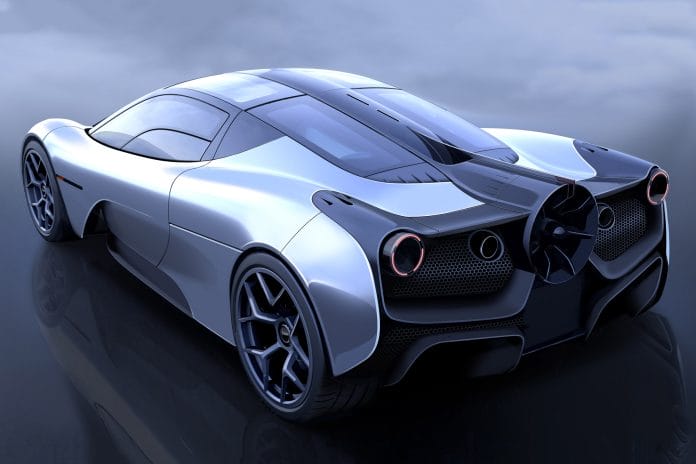
This is our first proper look at the Gordon Murray Automotive T.50, a car that has been coined as a McLaren F1 for the modern era – and that’s from the man responsible for the iconic supercar that won the Le Mans 24 Hours in 1995.
Legendary motorsport and automotive engineer Professor Gordon Murray is developing the ‘analogue’ supercar. It will be built in Britain and limited to 100 road car units, with a further 25 honed for track use.
This first rear-quarter image of the T.50 – which is due on the road in 2022 – reveals some of the groundbreaking aerodynamics that the car will employ. This includes a large 400mm ground-effect fan, inspired by the Brabham BT46B Formula One car designed by Murray in the late seventies.
But the complex aerodynamic systems extend beyond the fan. The car also has active under-body elements and rear aerofoils, plus there are six different aero modes and we’re told that the V12 engine and traction control settings are all configurable.
The T.50 will make use of a freshly developed 3.9-litre V12 from Cosworth. It makes up to 515kW using ram induction, has a 12,100rpm red line and 48-volt mild-hybrid assistance, while a proper manual gearbox will be fitted, too. And, just like the McLaren F1, the interior will feature a three-seat layout, with a central driving position set slightly ahead of the two passenger seats.
For now, all testing on the T.50 has been done on computer, using fluid dynamics. Later this year, physical models of the car will be tested in the wind tunnel used by the Racing Point Formula One team.
2020 will also see the opening of a Gordon Murray Automotive customer experience centre at Dunsfold Park, Surrey, where the car will be manufactured. Priced from £2 million (AUD$4m), the T.50 will be revealed to the world this May.
Q&A with Gordon Murray
Born in Durban, South Africa, Murray came to England in the late sixties and forged an engineering career in Formula One, creating a number of title-winning cars
Q: Would you describe this as a McLaren F1 for the modern era?
A: “I genuinely believe no one has done another F1 since the F1, almost 30 years ago, with the sort of focus on the driver, the engineering detail and a lightweight focus. One of the reasons the F1 became iconic is because every single thing for it was bespoke. This gets exactly the same starting point. From that point of view, it’s the F1 for the next generation, with all the same targets. But of course my toybox is much bigger now. We’ve got a much bigger and much more experienced team.”
Q: How many of the T.50’s 100 buyers already have an F1?
A: “I would say about a third are F1 owners. It’s the logical thing to do. The car’s going to be better than the F1 in every single way, so if you’ve got an F1 and you want to keep it without driving around in a £25 million car (AUD$50m), get in the T.50.”
Q: Is the 980kg weight of the T.50 the headline-grabbing figure?
A: “We’ve had some customers come here and go ‘it’s only got 690bhp!’ (515kW), but the power to weight is better than a LaFerrari or a McLaren P1 GTR. Do you really need to go 400km/h these days? I had no performance targets when I built the F1. It just turned out to be a very quick car. My target for this is it will be the best driver’s car and the most entertaining driver’s car ever made, full stop.”
Q: The F1 won Le Mans in 1995. Could you go racing with the T.50?
A: “I think they’d make us chuck the fan away! But we’ve done over 200 runs in the virtual wind tunnel and the figures it’s making, even without the fan, are competitive. The problem is that we’d have to add 300kg ballast, but I’m talking to the FIA [motorsport governing body] because I’d love to go racing again.”
Q: Is it difficult to homologate a ground-effect fan for a road car?
A: “Believe it or not, there are no regulations. It allows us to control the downforce much more, but it also allows us to do a very clean-looking car. I was desperate to get back to that. I wanted to get away from modern cars with holes and slats and ducts and slices down the sides and all that. The rear end is very technical, but the rest of the car is very beautiful, and I’ve had more fun than I’ve ever had designing this thing.
Q: Beyond the T.50, what vision do you have for Gordon Murray Automotive?
A: “This runs in parallel to the work Gordon Murray Design is doing on all sorts of vehicles. Just to give you a feel for that, we are busy prototyping our first autonomous electric pod, which is a single-person vehicle weighing 400kg. I don’t want to compete with Ferrari or McLaren or Aston Martin or anyone like that. We’ll always just make a few select vehicles for a few discerning people. They will always be unique, low-volume and top of their game.



